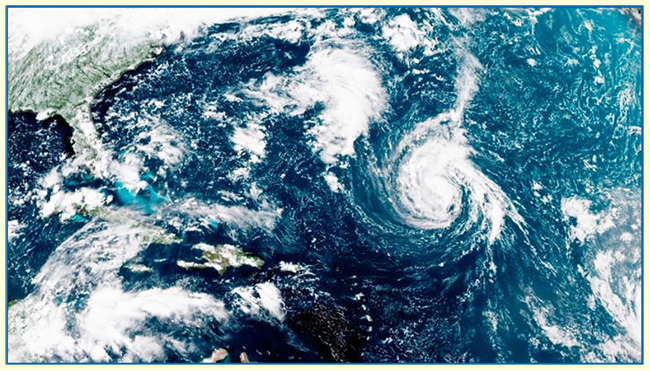— By Chris Gonzales, Freelance Science Writer, New York Sea Grant
Hempstead, NY, October 8, 2018 - How do you evacuate from a hurricane? First, turn on your TV or radio and listen for the latest emergency instructions. Restock your emergency preparedness kit. Plan for losing electricity and know you will need to communicate with your family members even without power. Review your evacuation route and shelter location. There’s nothing easy about it: It’s disruptive to pack up and go, even more so when your life and property are in danger.
Only one-third of coastal residents in Long Beach, NY left their homes prior to Superstorm Sandy in late October 2012, according to town officials. As a result of the storm, 90% of residents evacuated after the destruction was done: extensive damage to homes, streets and roads, and sanitation and sewer infrastructure. In the end, Superstorm Sandy killed 147 people, although no casualties were reported in Long Beach1. The storm caused 65 billion dollars in damage in the Mid-Atlantic and Northeastern United States2.

Planning is key to remaining safe from approaching severe storms. (Inset)
Study participant Vincent Contino takes a coastal storm awareness
survey on an iPad at the Cross Fit King of Island Park on April 29,
2015. Credit: FEMA / (Inset) E. Christa Farmer.
In a recently published study led by Elisabeth Ploran, Mary Anne Trasciatti, and E. Christa Farmer, all of Hofstra University, a team of researchers conducted personal interviews with 46 residents and analyzed survey answers from 225 respondents. All were from Long Beach.
The purpose of the study, funded through the National Oceanic and Atmospheric Administration and Sea Grant’s Coastal Storm Awareness Program (CSAP), was to understand why residents in danger do not always evacuate before storms.
The investigators found few residents cited authority figures such as government or emergency management officials in their decisions whether to evacuate.
Instead, they tended to get information from television as well as friends, family, and neighbors.
It must also be said, however, that residents understand how serious storms can be from technical weather information, and will evacuate if predictions are dire.
Results of the team’s study were recently published (2018) in the Journal of Applied Communication Research3.
Interestingly, the information coastal residents gave in person when filling out survey forms differed slightly from what others said in interviews. In survey responses, residents mentioned greater respect for traditional authority figures. However, in interviews, residents spoke more about friends and family.

(At Left) Anthony Eramo discusses coastal storm awareness at our public panel on April 30, 2015 at Hofstra University. Nelly Romero makes notes. (At Right) Erika Schaub makes a point about coastal storm awareness at the April 30, 2015 panel event at Hofstra, while Mary Anne Trasciatti moderates and Paul Wilders listens. Credit: E. Christa Farmer.
Long Beach, NY is a nine-mile-long barrier island that includes the City of Long Beach, population around 34,000. The island varies in width from 1,500 to 4,000 feet.
Bounded on all sides by water, it is low-lying and flat, generally less than 10 feet above National Geodetic Vertical Datum—a technical term akin to sea level.
Here, the team conducted interviews and collected surveys less than two years after landfall of Superstorm Sandy.
In interviews, researchers asked questions such as, “Did you remain in Long Beach the night of the storm?” and “Do you remember where you got your information about the storm?” They posed open-ended follow-up questions (i.e. “Can you tell me more about your decision [not] to evacuate?”)
When the researchers hand-coded the residents responses, they found the highest number of statements involved previous history with hurricanes, the role of friends and family, and miscellaneous items unrelated to major categories (i.e., a gut feeling, visual inspection of rising water.)
One finding of note: Residents indicated an increased openness to listen to local community organizers and amateur weather enthusiasts. It was as if people needed evidence of people’s expertise as well as local knowledge to be convinced the hurricane warnings were serious.

This enhanced satellite image shows Tropical Storm Florence, center, in the Atlantic Ocean in the afternoon of on Saturday, September 8, 2018. By the following morning the storm was upgraded to hurricane status. For more from NOAA on the 2018 hurricane season, see its late November press release, "Destructive 2018 Atlantic Hurricane Season Draws to an End" Credit: NOAA.
With this is mind, the authors suggest that there is an opportunity to create civil hurricane preparedness patrols, similar to what was set up during World War II for air raids.
By identifying and training a group of community members who can go door-to-door and serve as role models for evacuation, they might persuade residents to evacuate more readily, freeing up emergency personnel for other more urgent hurricane preparations.
Volunteers could perform and deliver pre-storm information and evacuation warnings as well. This would meet the expectations of residents seeking knowledgeable authority figures who demonstrate local, trusted frames of reference such as those typically held by family, friends, and neighbors.
“We are honored that we were chosen to pursue our proposed research under the Coastal Storm Awareness Program, and we are very grateful to all the undergraduate students who helped us collect data, as well as all the citizens who participated in our study,” said Farmer. “We hope that this information will help emergency managers develop better strategies to inform the public about coastal storms.”
“We think that the inclusion of information about sewer outages in emergency messages has the best potential to improve compliance with evacuation orders in the short-term,” continued Farmer. “We are also hopeful about the long-term strategy of forming citizen groups to increase communication at the local level, because this has great potential for increasing evacuation compliance as well. Overall, working on this project has been gratifying as well as sobering—we hope that the public can be better prepared for future storms.”
References
1 NOAA National Climatic Data Center, NOAA National Hurricane Center/National Weather Service
2 NOAA National Hurricane Center, www.nhc.noaa.gov/news/UpdatedCostliest.pdf
3 Elisabeth J. Ploran, Mary Anne Trasciatti & E. Christa Farmer (2018) Efficacy and authority of the message sender during emergency evacuations: a mixed methods study, Journal of Applied Communication Research, 46:3, 291-322, DOI:10.1080/00909882.2018.1464659
More Info: Severe Storms — Sea Grant on Lessons Learned from Superstorm Sandy
The 4-1/2 minute trailer for NOAA Sea Grant's Coastal Storm Awareness Program's 23-minute documentary, view-able on YouTube.
The key to CSAP, a $1.8M suite of 10 social science projects administered by Sea Grant programs in New York, New Jersey and Connecticut, is to help better understand how people respond to coastal storm warnings. "These storms will not go away," said NYSG former Director Bill Wise (retired). "They are likely to increase and, perhaps, become even more severe on average with global warming."
Findings from these 18-month community-based investigations are detailed in the news item "NOAA Sea Grant Coastal Storm Awareness Program Comes Ashore."
For more on NOAA Sea Grant's Coastal Storm Awareness Program see www.nyseagrant.org/csap.
More Info: New York Sea Grant
New York Sea Grant (NYSG), a cooperative program of Cornell University
and the State University of New York (SUNY), is one of 33 university-based
programs under the National Oceanic and Atmospheric Administration’s
National Sea Grant College Program.
Since 1971, NYSG has represented a statewide network of integrated
research, education and extension services promoting coastal community
economic vitality, environmental sustainability and citizen awareness
and understanding about the State’s marine and Great Lakes resources.
Through NYSG’s efforts, the combined talents of university scientists
and extension specialists help develop and transfer science-based
information to many coastal user groups—businesses and industries,
federal, state and local government decision-makers and agency managers,
educators, the media and the interested public.
The program maintains Great Lakes offices at Cornell University, SUNY
Buffalo, SUNY Oswego and the Wayne County Cooperative Extension office
in Newark. In the State's marine waters, NYSG has offices at Stony Brook
University in Long Island, Brooklyn College and Cornell Cooperative
Extension in NYC and Kingston in the Hudson Valley.
For updates on Sea Grant activities: www.nyseagrant.org has RSS, Facebook, Twitter, and YouTube links. NYSG offers a free e-list sign up via www.nyseagrant.org/nycoastlines for its flagship publication, NY Coastlines/Currents, which is published quarterly. Our program also produces an occasional e-newsletter,"NOAA Sea Grant's Social Media Review," via its blog, www.nyseagrant.org/blog.